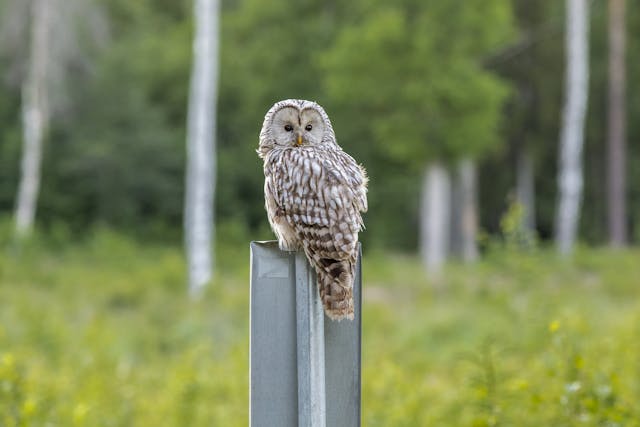
Why can owls turn their heads so far? Because their heads are only connected by one socket, which can rotate.
Owls are renowned for several things. One of them is their ability to swivel their heads completely around so they can keep an eye out for prey or predators. Being able to turn their heads without having to move gives them many advantages and helps keep them safe. They can turn their heads more quietly than they could turn their whole body, staying hidden. However, they cannot rotate their heads completely around. They can rotate them 270˚ in either direction. That means, they can look to their left and keep going until they are looking out across their right shoulder. Then they have to swivel back to the front to go the other way. Most humans can rotate their heads about 160˚ and very flexible people can probably go to about 180˚ .
Obviously, it is useful to be able to see behind you, but why would an owl need so much neck movement. The main reason is that owls cannot move their eyes. If we want to look behind, we don’t need to turn our heads so they are pointing backwards. When we turn our heads 90˚ so they are level with our shoulder, we can move our eyes and see behind. Owls cannot do this. We can move our eyes because we have eyeballs that can move in the eye socket. Owls don’t have eyeballs, they have eye cylinders. Owls hunt at night, which means they need very good night vision. The cornea is the part of the eye that let’s in light and to be able to see when there is not much light, like the night, requires a very big cornea. Owls have enormous corneas, but they only have very small skulls and that size cornea on a round, moving eye, would not fit in their head. So, they have cone shaped eyes that can accommodate the cornea, but those cone shaped eyes cannot move. That means they have to rotate their heads to see.
What is the difference between the necks of a human and an owl? There are two main differences. The first difference is the way the skull connects to the spine. Our skull is connected to the spine with two vertebrae: the C1 and the C2 vertebrae. Together, these two vertebrae are called the atlantoaxial joint. C1 is at the top and it can move forwards and backwards. This is what we use when we nod our heads or look up and down. C1 is shaped like a ring. C2 is underneath and has a peg-shaped projection that the ring of C1 fits over and this rotates from side to side. The bones, ligaments, and muscles turn and stretch far enough for the head to turn 180˚ at most, and won’t turn any more than that. Owl’s only have one vertebrae that connects to the skull, and this can rotate far more than our two. They also have a lot more smaller vertebrae, which add flexibility. Owls have holes in their vertebrae that hold air sacs, meant to cushion the neck, as well.
However, the flexible neck is not the real reason why they are able to turn their heads so far. The real reason is the way their blood vessels work. The arteries that provide the blood to our brain run up through holes in our vertebrae, up through the neck, and in to the skull from the bottom. These arteries pass through the atlantoaxial joint. As we turn our head, they constrict. If we keep turning our heads, they will be pinched so much that blood flow to the brain will be cut off. This is quite dangerous and is the reason why our muscles, bones, and ligaments don’t let us twist our heads further. Owls have evolved two ways to overcome this problem. First, they have far more blood vessels going through their neck and spine than we do. When they twist their head and blood gets cut off from one vessel, it can find a route through another vessel. There is always a path for the blood to take. Second, their arteries get larger above the neck, just under the skull. This enlarged artery holds more blood and can supply the brain with blood and oxygen when the owl turns its head and the blood vessel gets pinched off. All of these adaptations allow the owls to turn their heads as far as they can. And this is what I learned today.
Photo by Erik Karits: https://www.pexels.com/photo/brown-owl-perched-on-gray-post-3738686/
Sources
https://www.bbc.com/news/science-environment-21279609
https://www.spine-health.com/conditions/spine-anatomy/c1-c2-vertebrae-and-spinal-segment
https://www.mcgill.ca/oss/article/did-you-know/owls-dont-have-eyeballs
https://mayfieldclinic.com/pe-anatspine.htm
https://www.livescience.com/26771-how-owls-rotate-heads.html
https://www.nationalgeographic.com/animals/article/how-owls-twist-heads-almost-360-degrees
https://www.barnowl.co.uk/upload/docs/593/an_owls_vision.pdf
